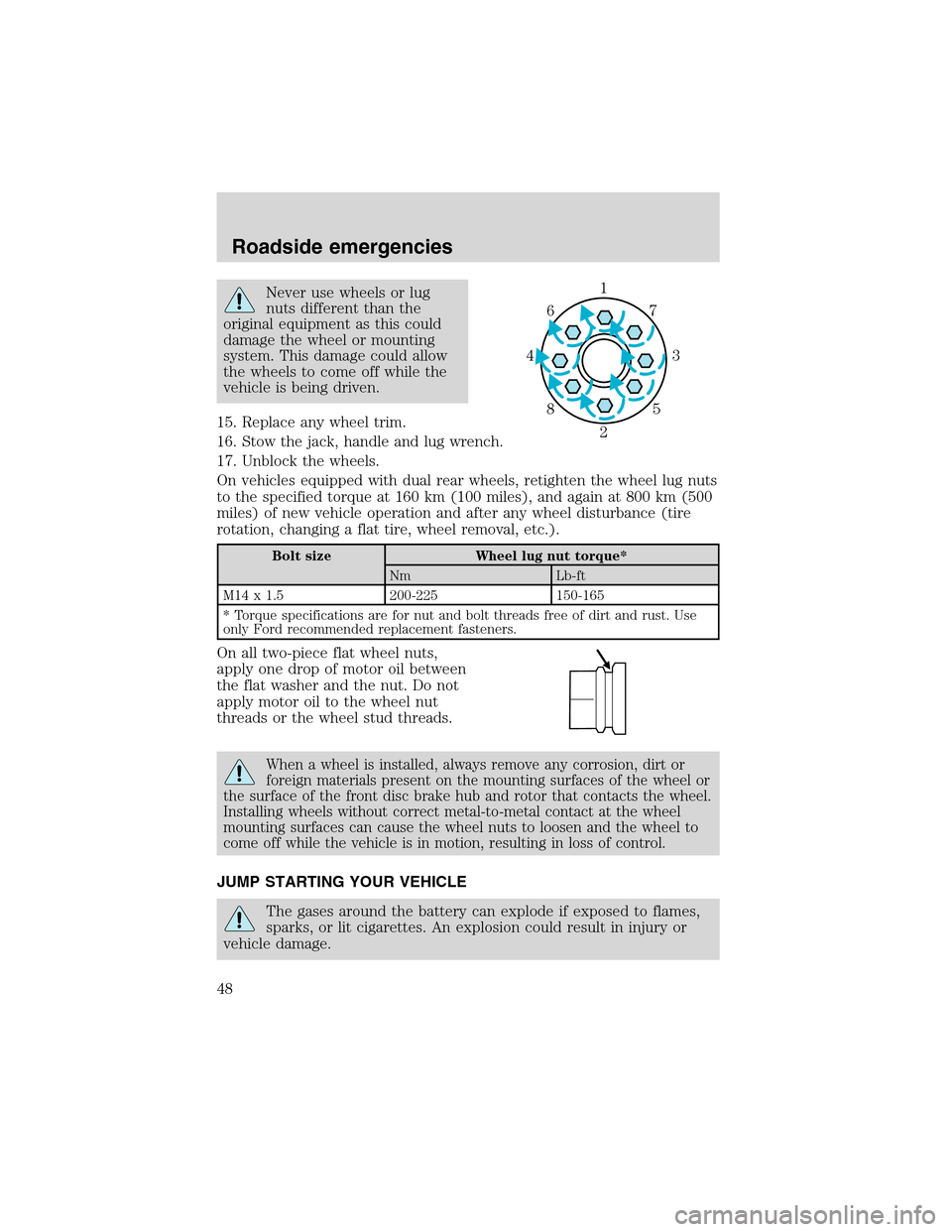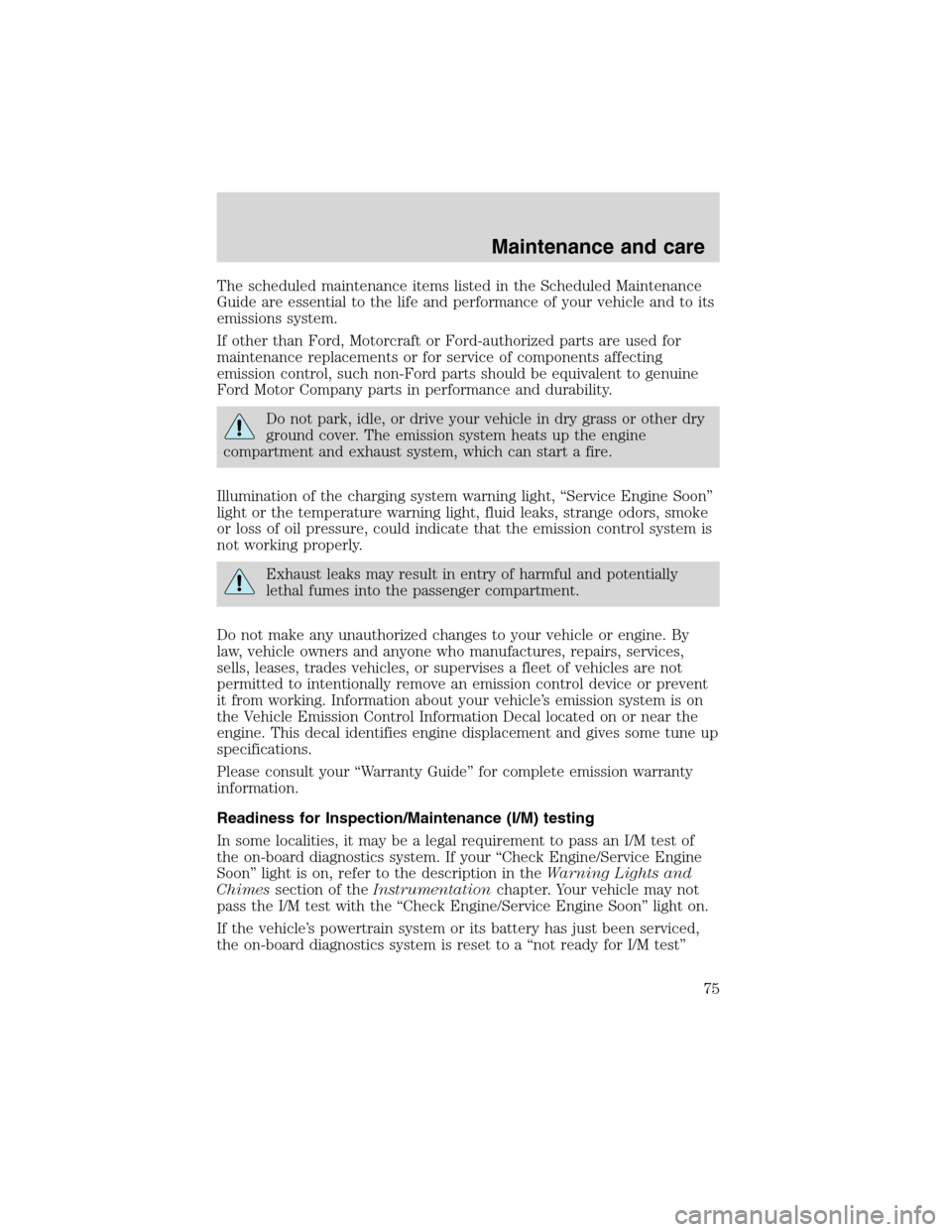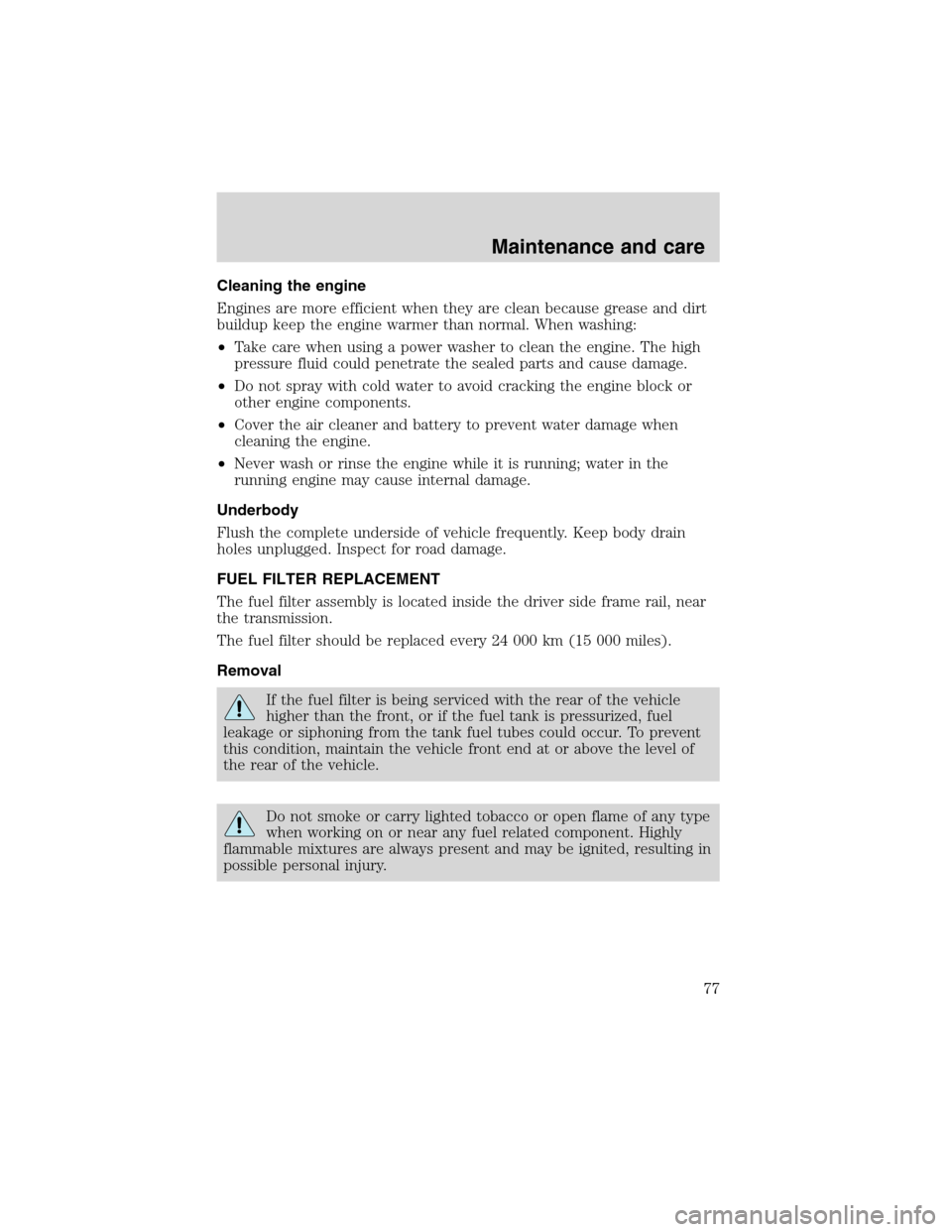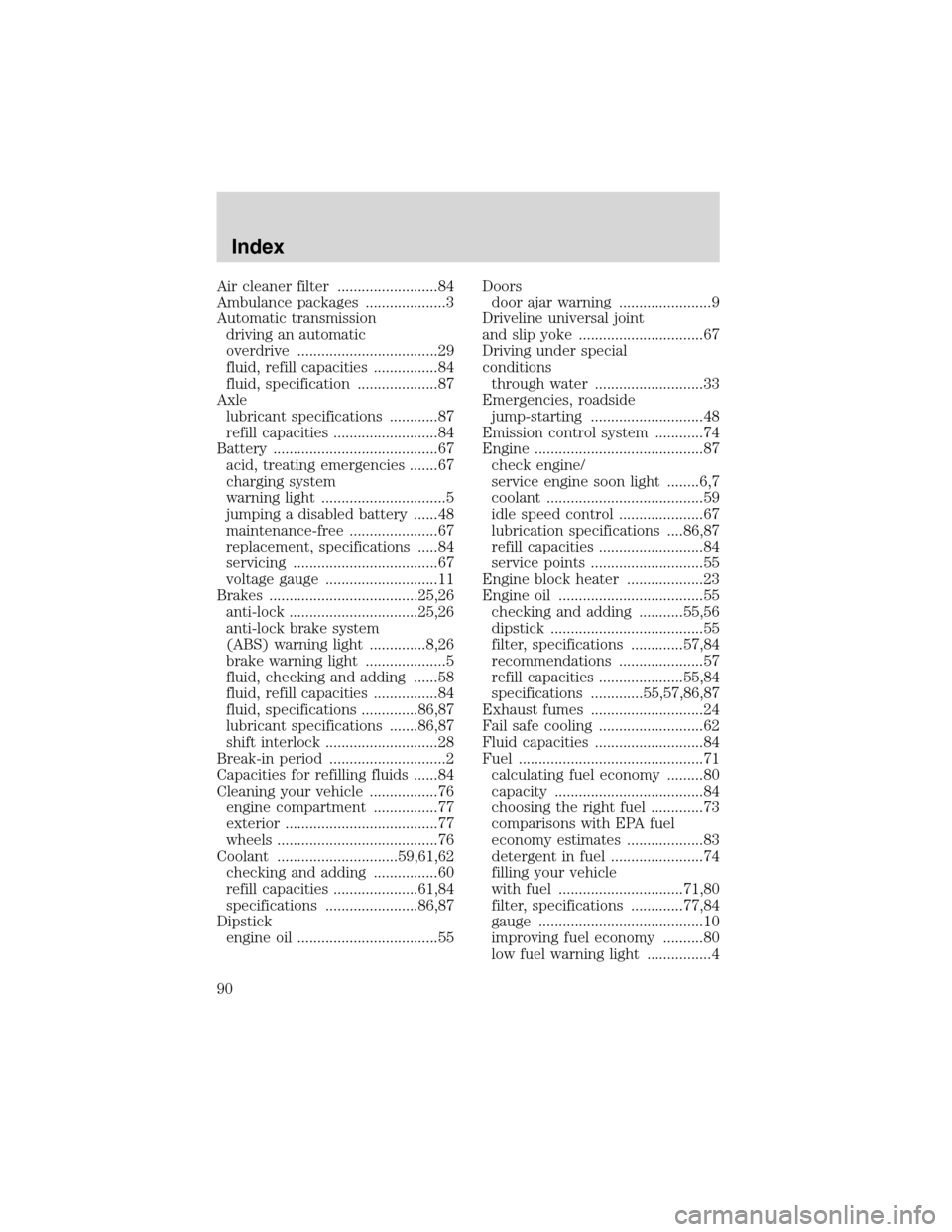battery replacement FORD F SERIES MOTORHOME AND COMMERCIAL CHASSIS 1999 10.G Owners Manual
[x] Cancel search | Manufacturer: FORD, Model Year: 1999, Model line: F SERIES MOTORHOME AND COMMERCIAL CHASSIS, Model: FORD F SERIES MOTORHOME AND COMMERCIAL CHASSIS 1999 10.GPages: 96, PDF Size: 0.57 MB
Page 48 of 96

Never use wheels or lug
nuts different than the
original equipment as this could
damage the wheel or mounting
system. This damage could allow
the wheels to come off while the
vehicle is being driven.
15. Replace any wheel trim.
16. Stow the jack, handle and lug wrench.
17. Unblock the wheels.
On vehicles equipped with dual rear wheels, retighten the wheel lug nuts
to the specified torque at 160 km (100 miles), and again at 800 km (500
miles) of new vehicle operation and after any wheel disturbance (tire
rotation, changing a flat tire, wheel removal, etc.).
Bolt size Wheel lug nut torque*
Nm Lb-ft
M14 x 1.5 200-225 150-165
* Torque specifications are for nut and bolt threads free of dirt and rust. Use
only Ford recommended replacement fasteners.
On all two-piece flat wheel nuts,
apply one drop of motor oil between
the flat washer and the nut. Do not
apply motor oil to the wheel nut
threads or the wheel stud threads.
When a wheel is installed, always remove any corrosion, dirt or
foreign materials present on the mounting surfaces of the wheel or
the surface of the front disc brake hub and rotor that contacts the wheel.
Installing wheels without correct metal-to-metal contact at the wheel
mounting surfaces can cause the wheel nuts to loosen and the wheel to
come off while the vehicle is in motion, resulting in loss of control.
JUMP STARTING YOUR VEHICLE
The gases around the battery can explode if exposed to flames,
sparks, or lit cigarettes. An explosion could result in injury or
vehicle damage.
1
3 4
27 6
5 8
Roadside emergencies
48
Page 75 of 96

The scheduled maintenance items listed in the Scheduled Maintenance
Guide are essential to the life and performance of your vehicle and to its
emissions system.
If other than Ford, Motorcraft or Ford-authorized parts are used for
maintenance replacements or for service of components affecting
emission control, such non-Ford parts should be equivalent to genuine
Ford Motor Company parts in performance and durability.
Do not park, idle, or drive your vehicle in dry grass or other dry
ground cover. The emission system heats up the engine
compartment and exhaust system, which can start a fire.
Illumination of the charging system warning light, “Service Engine Soon”
light or the temperature warning light, fluid leaks, strange odors, smoke
or loss of oil pressure, could indicate that the emission control system is
not working properly.
Exhaust leaks may result in entry of harmful and potentially
lethal fumes into the passenger compartment.
Do not make any unauthorized changes to your vehicle or engine. By
law, vehicle owners and anyone who manufactures, repairs, services,
sells, leases, trades vehicles, or supervises a fleet of vehicles are not
permitted to intentionally remove an emission control device or prevent
it from working. Information about your vehicle’s emission system is on
the Vehicle Emission Control Information Decal located on or near the
engine. This decal identifies engine displacement and gives some tune up
specifications.
Please consult your “Warranty Guide” for complete emission warranty
information.
Readiness for Inspection/Maintenance (I/M) testing
In some localities, it may be a legal requirement to pass an I/M test of
the on-board diagnostics system. If your “Check Engine/Service Engine
Soon” light is on, refer to the description in theWarning Lights and
Chimessection of theInstrumentationchapter. Your vehicle may not
pass the I/M test with the “Check Engine/Service Engine Soon” light on.
If the vehicle’s powertrain system or its battery has just been serviced,
the on-board diagnostics system is reset to a “not ready for I/M test”
Maintenance and care
75
Page 77 of 96

Cleaning the engine
Engines are more efficient when they are clean because grease and dirt
buildup keep the engine warmer than normal. When washing:
•Take care when using a power washer to clean the engine. The high
pressure fluid could penetrate the sealed parts and cause damage.
•Do not spray with cold water to avoid cracking the engine block or
other engine components.
•Cover the air cleaner and battery to prevent water damage when
cleaning the engine.
•Never wash or rinse the engine while it is running; water in the
running engine may cause internal damage.
Underbody
Flush the complete underside of vehicle frequently. Keep body drain
holes unplugged. Inspect for road damage.
FUEL FILTER REPLACEMENT
The fuel filter assembly is located inside the driver side frame rail, near
the transmission.
The fuel filter should be replaced every 24 000 km (15 000 miles).
Removal
If the fuel filter is being serviced with the rear of the vehicle
higher than the front, or if the fuel tank is pressurized, fuel
leakage or siphoning from the tank fuel tubes could occur. To prevent
this condition, maintain the vehicle front end at or above the level of
the rear of the vehicle.
Do not smoke or carry lighted tobacco or open flame of any type
when working on or near any fuel related component. Highly
flammable mixtures are always present and may be ignited, resulting in
possible personal injury.
Maintenance and care
77
Page 90 of 96

Air cleaner filter .........................84
Ambulance packages ....................3
Automatic transmission
driving an automatic
overdrive ...................................29
fluid, refill capacities ................84
fluid, specification ....................87
Axle
lubricant specifications ............87
refill capacities ..........................84
Battery .........................................67
acid, treating emergencies .......67
charging system
warning light ...............................5
jumping a disabled battery ......48
maintenance-free ......................67
replacement, specifications .....84
servicing ....................................67
voltage gauge ............................11
Brakes .....................................25,26
anti-lock ................................25,26
anti-lock brake system
(ABS) warning light ..............8,26
brake warning light ....................5
fluid, checking and adding ......58
fluid, refill capacities ................84
fluid, specifications ..............86,87
lubricant specifications .......86,87
shift interlock ............................28
Break-in period .............................2
Capacities for refilling fluids ......84
Cleaning your vehicle .................76
engine compartment ................77
exterior ......................................77
wheels ........................................76
Coolant ..............................59,61,62
checking and adding ................60
refill capacities .....................61,84
specifications .......................86,87
Dipstick
engine oil ...................................55Doors
door ajar warning .......................9
Driveline universal joint
and slip yoke ...............................67
Driving under special
conditions
through water ...........................33
Emergencies, roadside
jump-starting ............................48
Emission control system ............74
Engine ..........................................87
check engine/
service engine soon light ........6,7
coolant .......................................59
idle speed control .....................67
lubrication specifications ....86,87
refill capacities ..........................84
service points ............................55
Engine block heater ...................23
Engine oil ....................................55
checking and adding ...........55,56
dipstick ......................................55
filter, specifications .............57,84
recommendations .....................57
refill capacities .....................55,84
specifications .............55,57,86,87
Exhaust fumes ............................24
Fail safe cooling ..........................62
Fluid capacities ...........................84
Fuel ..............................................71
calculating fuel economy .........80
capacity .....................................84
choosing the right fuel .............73
comparisons with EPA fuel
economy estimates ...................83
detergent in fuel .......................74
filling your vehicle
with fuel ...............................71,80
filter, specifications .............77,84
gauge .........................................10
improving fuel economy ..........80
low fuel warning light ................4
Index
90